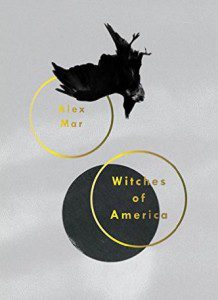Last night was Halloween, a time to dress up as ghosts, ghouls, goblins, and things that go bump in the night! In the tradition of Modern Paganism, this same night is known as Samhain (pronounced “sow-in”), and it is a time that is particularly auspicious for remembering one’s ancestors. On this day after Halloween, the Pagan tradition is also a reminder that some among us identify as witches all year long — and in a way that differs from the exaggerated forms of Halloween costumes.
For example, I was interested this past year to see that Alex Mar’s book Witches of America had been named one of The New York Times’s Top 100 Books of the Year for 2015. Here’s how Mar describes herself:
Raised in Manhattan, I confirm plenty of the stereotypes of a New Yorker: an overeducated liberal, a feminist, a skeptic long suspicious of organized religions, surrounded by friends…who consider agnosticism an uncomfortable level of devotion….I believe in something transcendent, but I’ve yet to meet someone with a convincing label for it. (4)
Her book is a memoir about her five-year, in-depth journey of exploring modern Paganism. I appreciated her book, and would recommend it to anyone interested. However, there are also some heated debates online about whether Mar’s descriptions of modern Pagans are fair: some Pagans agree, others disagree. I would like to use that tension between how one would describe oneself compared with how others might describe you as a starting point for exploring some of why Paganism is understood differently depending on one’s worldview and experience.
book, and would recommend it to anyone interested. However, there are also some heated debates online about whether Mar’s descriptions of modern Pagans are fair: some Pagans agree, others disagree. I would like to use that tension between how one would describe oneself compared with how others might describe you as a starting point for exploring some of why Paganism is understood differently depending on one’s worldview and experience.
Since we’re also now a mere week away from a U.S. Presidential election, allow me to use a political analogy to help explain the ways that different groups understand and react to Paganism. Consider, for example, that the way Hillary Clinton describes herself, her policies, and her aspirations is starkly different from the way that Donald Trump describes her. The inverse is also true: Donald would use different words and frameworks to describe himself and his campaign than Hillary would. There are rare cases of people describing their opponents in the most charitable terms before attempting to prove them wrong. But far too often, we frame our opponents in the least charitable way — or even a misleading, false way — and then knock down that “straw man.”
A similar dynamic is at play, for instance, with the terms “Christian” and “Pagan.” Many Christians would prefer to describe themselves as people who seek to follow Jesus’s way of love, forgiveness, and mercy. But some opponents of Christianity would prefer to describe Christians from a different perspective, using words like “hypocritical,” “bigoted against homosexuality,” “sheltered,” and “judgmental.”
Similarly, Pagans (from the Latin word paganus) used to mean peasants: “A pagus was a country district, a paganus someone who lived there….” Likewise, the word heathen originally meant someone from the “heath,” who lived in the country, not the city. It was not until the rise of Christianity, which occurred particularly in the cities of the Roman Empire, that country-dwelling Pagans and heathens (who continued to celebrate their traditional local gods) came to be seen as infidels, idolaters, and heretics. Before Christianity tried to lump a wide diversity of polytheistic traditions together as “Paganism,” pagans were simply peasants following various local customs and traditions.
So instead of how others might describe Pagans, I invite you to consider one example from the late Margot Adler — the NPR reporter, Unitarian Universalist, and author of one of the definitive guides to the modern Pagan movement in the U.S. — about how many modern Pagans today might describe themselves:
-
[They] sense an aliveness and “presence” in nature….
-
They share the goal of living in harmony with nature and they tend to view humanity’s “advancement” and separation from nature as the prime source of alienation. They see ritual as a tool to end that alienation….
-
They gravitate to ancient symbols and ancient myths, to the old polytheistic religions.… They are reclaiming these sources, transforming them….
-
They do not regard pleasure as sinful, nor do they conceive of this world as a burden.
-
While many of their members lead quite ordinary, and often successful, lives in the “real world,” they are able to detach themselves from many of the trends of the day, maintaining a sense of humor, a gentle anarchism, and a remarkable tolerance for diversity….
-
This religious movement…is only partly an “occult” phenomenon [“that which is hidden or beyond the range of ordinary apprehension and understanding”].
-
Often it is interwoven with the visionary and artistic tradition, the ecology movement, the feminist movement, and the libertarian tradition. (4-5, 466)
All that being said, because Paganism both historically and today is decentralized, it is also the case that if you ask three Pagans about Paganism, you might get two, three, four, or more different opinions — not that there’s anything wrong with that! Relatedly, I should mention that regarding the number of Pagans in the United States today, one of the most recent estimates I have seen is “as many as one million people” (Mar 12).
Personally, I find one of the most compelling parts of Paganism to be the focus on the Wheel of the Year. If you imagine a year as a circle, most of us are familiar with the four major quadrants: Winter, Spring, Summer, and Fall. Paganism adds the additional nuance of cross-quarter days, which further divides the year into a total of eight turning points:
- In between Winter Solstice and Spring Equinox is Imbolc, an invitation to celebrate the lengthening daylight. (This Pagan holiday has been secularized as “Groundhog’s Day.”)
- In between Spring Equinox and Summer Solstice is Beltane, most famous for the tradition of dancing around a May Pole. (Beltane has been secularized as “May Day.”)
- In between Summer Solstice and Fall Equinox is Lammas. Lammas celebrates the gratitude and abundance of the year’s First Harvest.
- In between Fall Equinox and Winter Solstice, is Samhain (also known as All Hallow’s Eve or Halloween), a time, in particular, for remembering your ancestors.
For now, on this day after Samhain, can you feel the Wheel of the Year turning? And in the days and weeks to come, what wisdom might there be for you from the Earth-centered tradition of Paganism?
The Rev. Dr. Carl Gregg is a trained spiritual director, a D.Min. graduate of San Francisco Theological Seminary, and the minister of the Unitarian Universalist Congregation of Frederick, Maryland. Follow him on Facebook (facebook.com/carlgregg) and Twitter (@carlgregg).
Learn more about Unitarian Universalism: http://www.uua.org/beliefs/principles
















